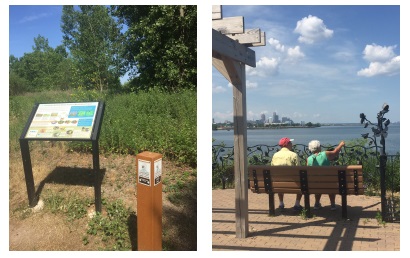
Created by dredged material from Cleveland Harbor, the Cleveland Lakefront Nature Preserve is a popular recreation area and habit for wild mammals, reptiles, butterflies and 280 species of birds.
Photos/Port of Cleveland
Port Everglades Partners with EPA to Study Air Emissions
Port Everglades has signed a partnership agreement with the U.S. Environmental Protection Agency (EPA) to study air emissions.
"Port Everglades is not only proud to take our commitment to environmental stewardship to another level, but to do so by being the first U.S. seaport to partner with the EPA on this project," said Port Director Steven Cernak, PPM®. "While Port Everglades already meets environmental standards for air quality, we want to have a benchmark to measure any changes."
The EPA's Office of Transportation and Air Quality will work with Port Everglades to coordinate research and modeling encompassing all port-related operations, technologies and anticipated growth scenarios. The EPA also intends to develop separate emissions estimates for areas outside the Port's jurisdictional boundaries, such as highways and railroads used by Port Everglades customers.
"This agreement is an important step forward in developing emission reduction scenarios and inventories for port communities," said Christopher Grundler, director of EPA's Office of Transportation and Air Quality. "With this collaborative initiative, together EPA and Port Everglades can support sustainable development and cleaner air."
As part of the agreement, the port is providing a baseline emissions inventory for EPA's analysis. Port Everglades contracted with a consulting group to collect the data needed to generate a 2015 emission inventory for the port.
The EPA will use the findings of the emissions inventory to help Port Everglades set goals to reduce emissions.
Future emission inventories will evaluate the effectiveness of new technology and operational strategies used to reduce emissions at the port and surrounding areas. The partnership will allow the EPA to develop methods, provide lessons learned, and provide practical examples that can be shared with other ports, related agencies and stakeholders to support and encourage sustainable development.
For more information on the EPA's Ports Initiative and the partnership agreement, visit http://www.epa.gov/ports--initiative.
Port Everglades has signed a partnership agreement with the U.S. Environmental Protection Agency (EPA) to study air emissions.
"Port Everglades is not only proud to take our commitment to environmental stewardship to another level, but to do so by being the first U.S. seaport to partner with the EPA on this project," said Port Director Steven Cernak, PPM®. "While Port Everglades already meets environmental standards for air quality, we want to have a benchmark to measure any changes."
The EPA's Office of Transportation and Air Quality will work with Port Everglades to coordinate research and modeling encompassing all port-related operations, technologies and anticipated growth scenarios. The EPA also intends to develop separate emissions estimates for areas outside the Port's jurisdictional boundaries, such as highways and railroads used by Port Everglades customers.
"This agreement is an important step forward in developing emission reduction scenarios and inventories for port communities," said Christopher Grundler, director of EPA's Office of Transportation and Air Quality. "With this collaborative initiative, together EPA and Port Everglades can support sustainable development and cleaner air."
As part of the agreement, the port is providing a baseline emissions inventory for EPA's analysis. Port Everglades contracted with a consulting group to collect the data needed to generate a 2015 emission inventory for the port.
The EPA will use the findings of the emissions inventory to help Port Everglades set goals to reduce emissions.
Future emission inventories will evaluate the effectiveness of new technology and operational strategies used to reduce emissions at the port and surrounding areas. The partnership will allow the EPA to develop methods, provide lessons learned, and provide practical examples that can be shared with other ports, related agencies and stakeholders to support and encourage sustainable development.
For more information on the EPA's Ports Initiative and the partnership agreement, visit http://www.epa.gov/ports--initiative.